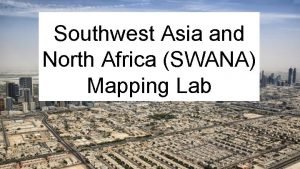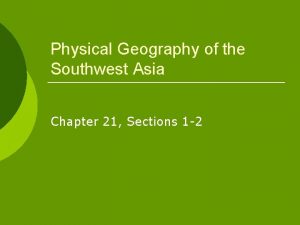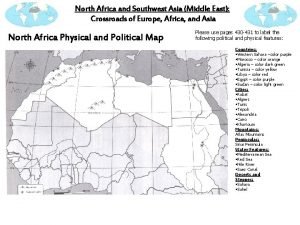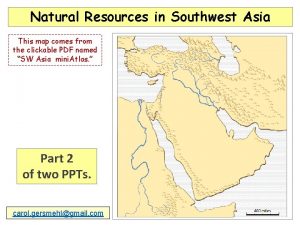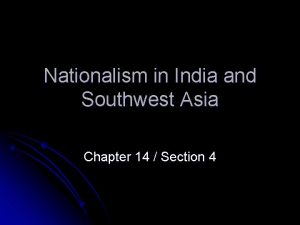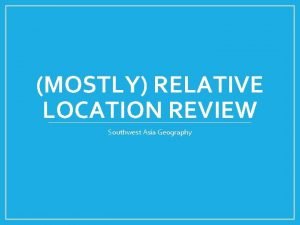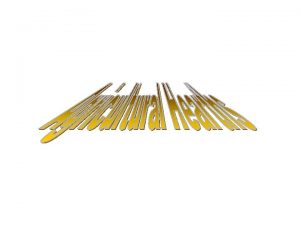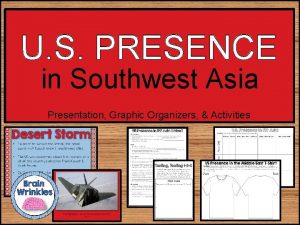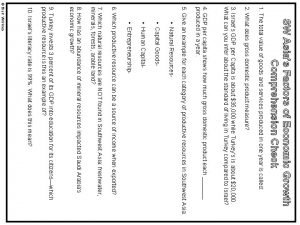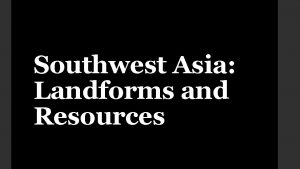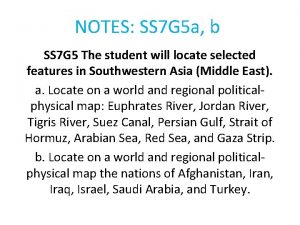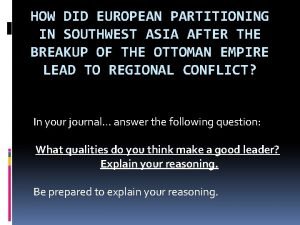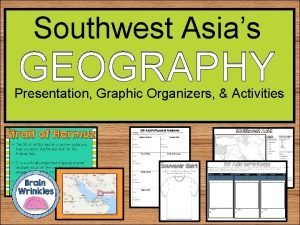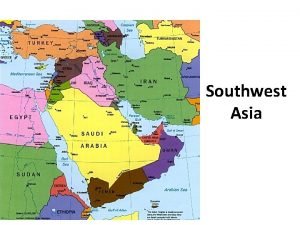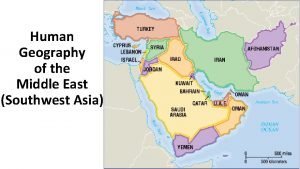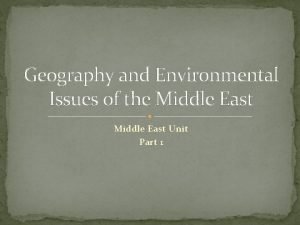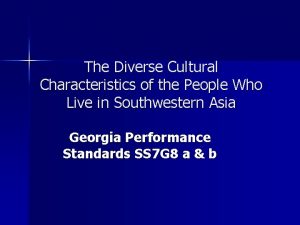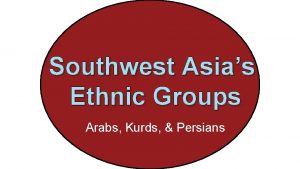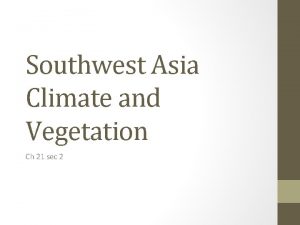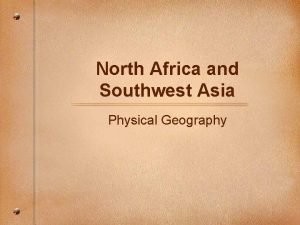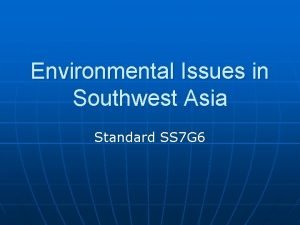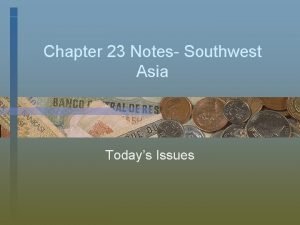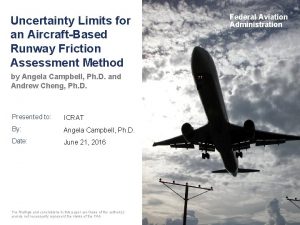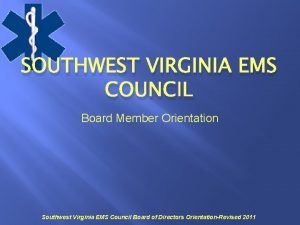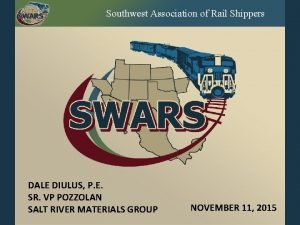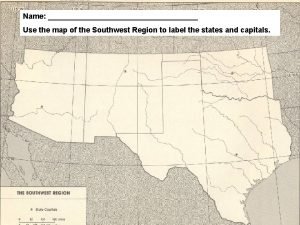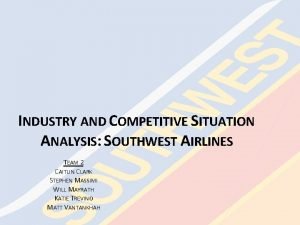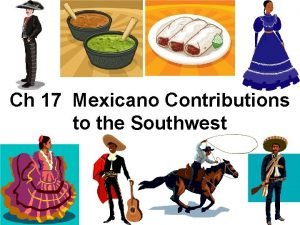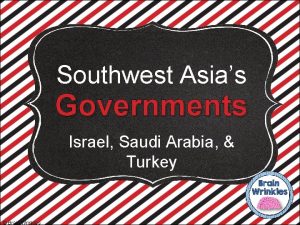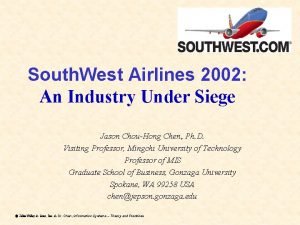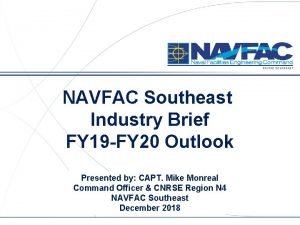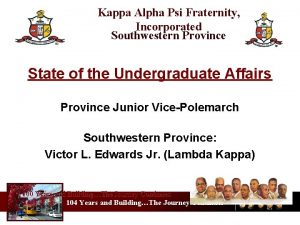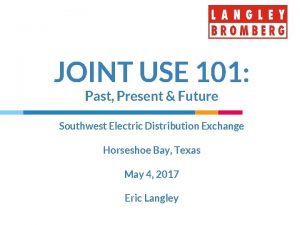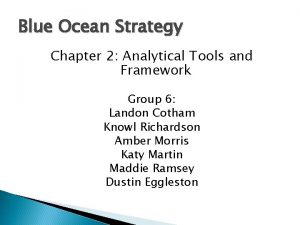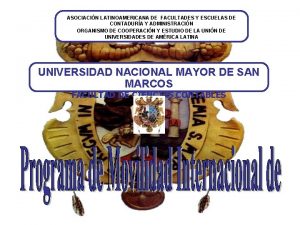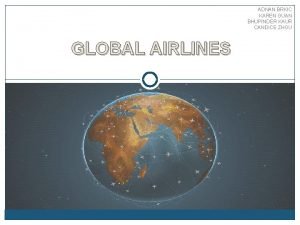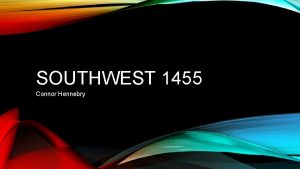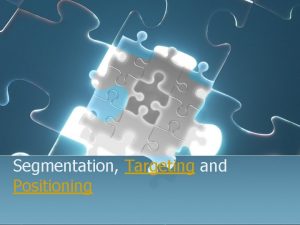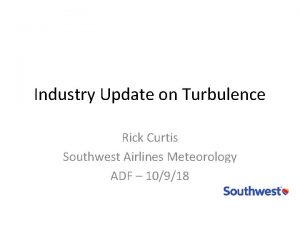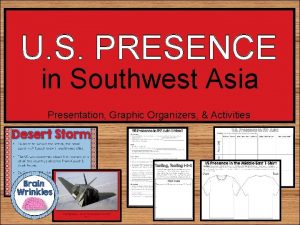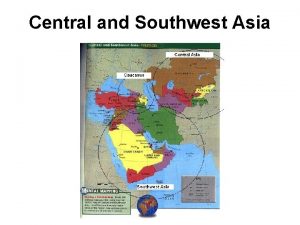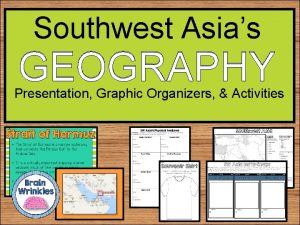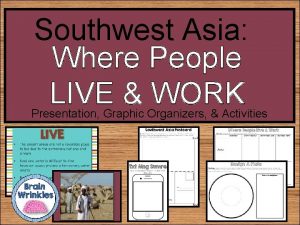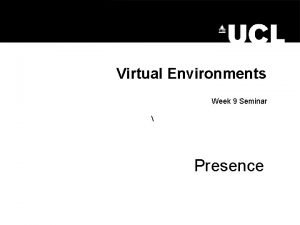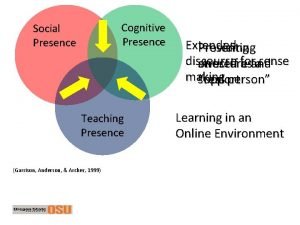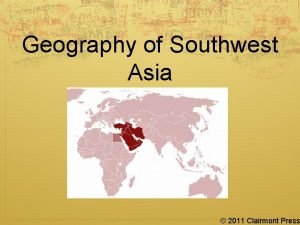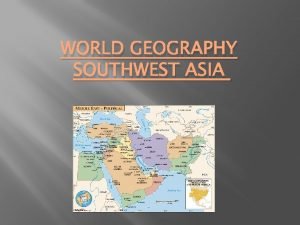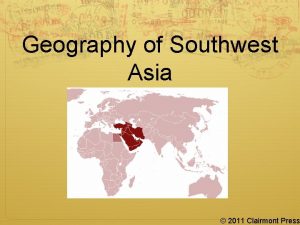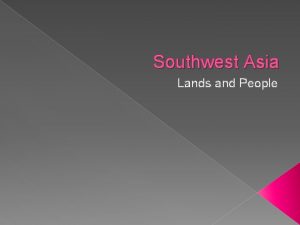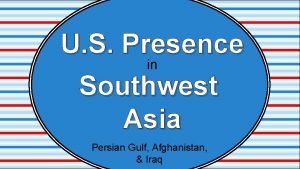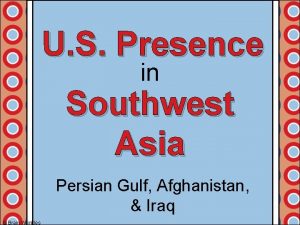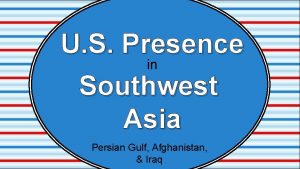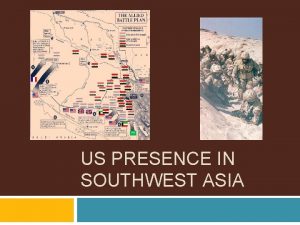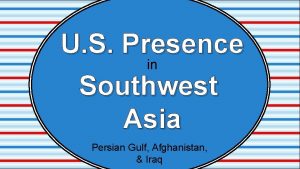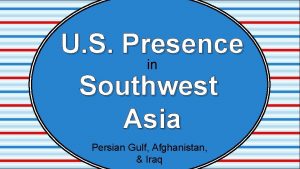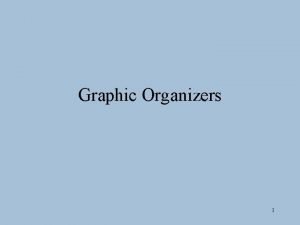U S PRESENCE in Southwest Asia Presentation Graphic



































































- Slides: 67

U. S. PRESENCE in Southwest Asia Presentation, Graphic Organizers, & Activities

Sponge #31/32

STANDARDS: SS 7 H 2 Analyze continuity and change in Southwest Asia (Middle East). d. Explain U. S. presence and interest in Southwest Asia, including the Persian Gulf conflict and invasions of Afghanistan and Iraq. © Brain Wrinkles

US Presence in SW Asia Notes 1 U. S. Presence • The United States has great interest in maintaining stability in Southwest Asia to safeguard the _____________ and to combat terrorism. • Beginning in the late 20 th century, the US has had a _____________ in this area of the world. Kuwait • In 1920, the country of _____________. • As a result, Iraq lost its access to the _____________. • _____________, Iraq’s dictator, wanted to get this access back and to acquire access to Kuwait’s many oil fields. • Iraqi forces invaded Kuwait in _____________. Desert Storm • In order to survive the attack, the small country of Kuwait knew it would _____________. • The US was concerned about this invasion, as a lot of the _____________ came from Kuwait & Saudi Arabia. • In January 1991, the United States and a group of other countries started “Operation Desert Storm”, a military _____________. • The coalition employed missile attacks and used ground forces to quickly drive Iraqi forces out of Kuwait in _____________. • By February of 1991, the Iraqi government _____________ and withdrew from Kuwait. • Iraq left, but not before Saddam Hussein had his soldiers set nearly 1, 000 _____________ , causing immense environmental damage. • Both Iraq and Kuwait were _____________ during the war. UN Embargo • When Iraq invaded Kuwait, the United Nations _____________ that prevented Iraq from exporting oil or importing goods. • The UN would not lift the embargo until Iraq destroyed its ___________________ and promised to stop making nuclear weapons. • This process began in 1991, and when the UN inspection team left in 1998, there was speculation that _____________ had actually been destroyed. © Brain Wrinkles

US Presence in SW Asia Notes 2 Iraq • After the UN inspection team left, many Americans believed that Hussein was hiding _____________ (WMDs) throughout the country, as well as providing aid to _____________. • In 2003, the United States, Great Britain, Australia, & other countries launched a military invasion of Iraq called “_____________ ”. Results • Saddam Hussein’s _____________ , and the military operation was over in less than two months. • _____________ were ever found. • In _____________ , Hussein was captured, tried, and sentenced to death. • _____________ in December 2006. Iraq Today • Rebuilding Iraq after the invasion _____________. • In 2005, Iraqi citizens took part in free elections to establish a new _____________. • U. S. forces remained in Iraq until the new Iraqi government was _____________. • In December 2011, the _____________. • Unfortunately, there is still conflict in Iraq today, as the _____________ are fighting one another for power of the country. © Brain Wrinkles

US Presence in SW Asia Notes 3 Bin Laden • In 1996, the Taliban (an _____________ ) established power in Afghanistan. • The _____________ was thought to be harboring Osama bin Laden’s terrorist group al-Qaeda, whose goal was to bring an _____________ in the Middle East. • The U. S. government identified bin Laden as the most likely suspect responsible for the September 11 th, 2001 attacks on the _____________ and the Pentagon. 9/11 • On September 11, 2001, al-Qaeda _____________ in the United States. • The terrorists _____________. • _____________ into the World Trade Center in New York City. • Another airplane crashed into the _____________ , just outside of Washington, DC. • The fourth plane was intended to _____________ , but crashed in rural Pennsylvania. • Over _____________ in these attacks. US Invasion • Sources in the U. S. government believed that the Taliban was allowing Bin Laden and his _____________ in the mountains of Afghanistan. • On October 7 th, 2001, U. S. troops entered Afghanistan to _____________ and locate bin Laden. Democracy • After launching a series of attacks, the _____________. • The U. S. helped form a new _____________ in Afghanistan. • Efforts to locate bin Laden failed, and he went into hiding for the next _____________. The End • On _____________ , at 1: 00 am, Navy SEALS raided Osama bin Laden’s compound in Pakistan. • Bin Laden was shot and _____________. • His body was taken to Afghanistan for identification, then _____________ within 24 hours. • According to U. S. officials, bin Laden was buried at sea because _____________ would accept his remains. © Brain Wrinkles

US Presence in SW Asia Notes 1 U. S. Presence • The United States has great interest in maintaining stability in Southwest Asia to safeguard the supply of oil and to combat terrorism. • Beginning in the late 20 th century, the US has had a major presence in this area of the world. Kuwait • In 1920, the country of Kuwait was created. • As a result, Iraq lost its access to the Persian Gulf. • Saddam Hussein, Iraq’s dictator, wanted to get this access back and to acquire access to Kuwait’s many oil fields. • Iraqi forces invaded Kuwait in August 1990. Desert Storm • In order to survive the attack, the small country of Kuwait knew it would need allies. • The US was concerned about this invasion, as a lot of the country’s oil came from Kuwait & Saudi Arabia. • In January 1991, the United States and a group of other countries started “Operation Desert Storm”, a military mission to recapture Kuwait. • The coalition employed missile attacks and used ground forces to quickly drive Iraqi forces out of Kuwait in just six weeks. • By February of 1991, the Iraqi government agreed to a truce and withdrew from Kuwait. • Iraq left, but not before Saddam Hussein had his soldiers set nearly 1, 000 oil fields on fire, causing immense environmental damage. • Both Iraq and Kuwait were badly damaged during the war. UN Embargo • When Iraq invaded Kuwait, the United Nations imposed an embargo that prevented Iraq from exporting oil or importing goods. • The UN would not lift the embargo until Iraq destroyed its chemical and biological weapons and promised to stop making nuclear weapons. • This process began in 1991, and when the UN inspection team left in 1998, there was speculation that only 85% had actually been destroyed. © Brain Wrinkles

US Presence in SW Asia Notes 2 Iraq • After the UN inspection team left, many Americans believed that Hussein was hiding weapons of mass destruction (WMDs) throughout the country, as well as providing aid to members of al-Qaeda. • In 2003, the United States, Great Britain, Australia, & other countries launched a military invasion of Iraq called “Operation Iraqi Freedom”. Results • Saddam Hussein’s government collapsed quickly, and the military operation was over in less than two months. • No WMDs were ever found. • In December 2003, Hussein was captured, tried, and sentenced to death. • He was executed in December 2006. Iraq Today • Rebuilding Iraq after the invasion has been difficult. • In 2005, Iraqi citizens took part in free elections to establish a new democratic government. • U. S. forces remained in Iraq until the new Iraqi government was secure and stable. • In December 2011, the U. S. forces withdrew. • Unfortunately, there is still conflict in Iraq today, as the Shia and Sunni Muslims are fighting one another for power of the country. © Brain Wrinkles

US Presence in SW Asia Notes 3 Bin Laden • In 1996, the Taliban (an extremely religious group) established power in Afghanistan. • The anti-American Taliban was thought to be harboring Osama bin Laden’s terrorist group al-Qaeda, whose goal was to bring an end to Western influence in the Middle East. • The U. S. government identified bin Laden as the most likely suspect responsible for the September 11 th, 2001 attacks on the World Trade Center and the Pentagon. 9/11 • On September 11, 2001, al-Qaeda attacked three targets in the United States. • The terrorists hijacked four planes. • Two planes crashed into the World Trade Center in New York City. • Another airplane crashed into the Pentagon in Virginia, just outside of Washington, DC. • The fourth plane was intended to hit the White House, but crashed in rural Pennsylvania. • Over 3, 000 people were killed in these attacks. US Invasion • Sources in the U. S. government believed that the Taliban was allowing Bin Laden and his followers to hide out in the mountains of Afghanistan. • On October 7 th, 2001, U. S. troops entered Afghanistan to disable the Taliban and locate bin Laden. Democracy • After launching a series of attacks, the Taliban was defeated. • The U. S. helped form a new democratic government in Afghanistan. • Efforts to locate bin Laden failed, and he went into hiding for the next ten years. The End • On May 2, 2011, at 1: 00 am, Navy SEALS raided Osama bin Laden’s compound in Pakistan. • Bin Laden was shot and killed in the raid. • His body was taken to Afghanistan for identification, then buried at sea within 24 hours. • According to U. S. officials, bin Laden was buried at sea because no country would accept his remains. © Brain Wrinkles

U. S. Presence in Southwest Asia Persian Gulf, Afghanistan, & Iraq © Brain Wrinkles

U. S. Presence • The United States has great interest in maintaining stability in Southwest Asia to: • 1. ) Safeguard the supply of oil, • 2. ) Protect Israel (close ally), and • 3. ) Combat terrorism. • Beginning in the late 20 th century, the US has had a major presence in this area of the world. © Brain Wrinkles

Activator: United Streaming Video Clips � Osama Bin Laden and Saddam Hussein � https: //app. discoveryeducation. com/learn/vi deos/918 C 635 F-B 8 F 9 -4706 -8118 D 1 E 2462 D 6 DB 4? has. Local. Host=false

Persian Gulf Conflict Operation Desert Storm © Brain Wrinkles

Kuwait • In 1920, the country of Kuwait was created. • As a result, Iraq lost its access to the Persian Gulf. • Saddam Hussein, Iraq’s dictator, wanted to get this access back and to acquire access to Kuwait’s many oil fields. • Iraqi forces invaded Kuwait in August © Brain Wrinkles

© Brain Wrinkles

Saddam Hussein © Brain Wrinkles

August 2 nd, 1990 – Iraq invades Kuwait © Brain Wrinkles

Desert Storm • In order to survive the attack, the small country of Kuwait knew it would need allies. • The US was concerned about this invasion, as a lot of the country’s oil came from Kuwait & Saudi Arabia. • In January 1991, the United States and a group of other countries started “Operation Desert Storm”, a military mission to recapture Kuwait. © Brain Wrinkles

© Brain Wrinkles

Blue = Coalition Nations © Brain Wrinkles

A US Nighthawk – one of the key players in Desert Storm. © Brain Wrinkles

Desert Storm • The coalition employed missile attacks and used ground forces to quickly drive Iraqi forces out of Kuwait in just six weeks. • By February of 1991, the Iraqi government agreed to a truce and withdrew from Kuwait. • Iraq left, but not before Saddam Hussein had his soldiers set nearly 1, 000 oil fields on fire, causing immense environmental damage. • Both Iraq and Kuwait were badly damaged during the war. © Brain Wrinkles

Oil fires set in Kuwait by Iraqi forces. © Brain Wrinkles

Destroyed military & civilian vehicles along the “Highway of Death”, a six mile stretch of road between Kuwait and Iraq. © Brain Wrinkles

Afghanistan Invasion Operation Enduring Freedom © Brain Wrinkles

Bin Laden • In 1996, the Taliban (an extremely religious group) established power in Afghanistan. • The anti-American Taliban was thought to be harboring Osama bin Laden’s terrorist group al-Qaeda, whose goal was to bring an end to Western influence in the Middle East. • The U. S. government identified bin Laden as the most likely suspect responsible for the September 11 th, 2001 attacks on the World Trade Center and the Pentagon. © Brain Wrinkles

Osama bin Laden © Brain Wrinkles

Al-Qaeda © Brain Wrinkles

9/11 • On September 11, 2001, al-Qaeda attacked three targets in the United States. • The terrorists hijacked four planes. • Two planes crashed into the World Trade Center in New York City. • Another airplane crashed into the Pentagon in Virginia, just outside of Washington, DC. • The fourth plane was intended to hit the White House, but crashed in rural Pennsylvania. • Over 3, 000 people were killed in these attacks. © Brain Wrinkles

Two days after the September 11 attacks, U. S. President George W. Bush stated: "The most important thing is for us to find Osama bin Laden. It is our number one priority and we will not rest until © Brain Wrinkles

US Invasion • Sources in the U. S. government believed that the Taliban was allowing Bin Laden and his followers to hide out in the mountains of Afghanistan. • On October 7 th, 2001, U. S. troops entered Afghanistan to disable the Taliban and locate bin Laden. © Brain Wrinkles

Democracy • After launching a series of attacks, the Taliban was defeated. • The U. S. helped form a new democratic government in Afghanistan. • Efforts to locate bin Laden failed, and he went into hiding for the next ten years. © Brain Wrinkles

U. S. troops in Afghanistan in 2001. © Brain Wrinkles

2004 – Hamid Karzai became the first democratically elected president of © Brain Wrinkles

The End • On May 2, 2011, at 1: 00 am, Navy SEALS raided Osama bin Laden’s compound in Pakistan. • Bin Laden was shot and killed in the raid. • His body was taken to Afghanistan for identification, then buried at sea within 24 hours. • According to U. S. officials, bin Laden was buried at sea because no country would © Brain Wrinkles accept his remains.

Osama bin Laden’s compound in Pakistan where he was found in 2011. © Brain Wrinkles

© Brain Wrinkles

Iraq Invasion Operation Iraqi Freedom © Brain Wrinkles

UN Embargo • When Iraq invaded Kuwait, the United Nations imposed an embargo that prevented Iraq from exporting oil or importing goods. • The UN would not lift the embargo until Iraq destroyed its chemical and biological weapons and promised to stop making nuclear weapons. • This process began in 1991, and when the UN inspection team left in 1998, there was speculation that only 85% had actually been © Brain Wrinkles

Iraq • After the UN inspection team left, many Americans believed that Hussein was hiding weapons of mass destruction (WMDs) throughout the country, as well as providing aid to members of al-Qaeda. • In 2003, the United States, Great Britain, Australia, & other countries launched a military invasion of Iraq called “Operation Iraqi Freedom”. © Brain Wrinkles

UN weapons inspector taking samples at an Iraqi factory in 2002. © Brain Wrinkles

U. S. marines enter a palace in Baghdad. U. S. marines fire a M 198 Medium Howitzer. © Brain Wrinkles

Results • Saddam Hussein’s government collapsed quickly, and the military operation was over in less than two months. • No WMDs were ever found. • In December 2003, Hussein was captured, tried, and sentenced to death. • He was executed in December 2006. © Brain Wrinkles

Saddam Hussein was found hiding in a hole armed with a pistol, an AK-47 assault rifle, and $750, 000 cash. © Brain Wrinkles

Iraq Today • Rebuilding Iraq after the invasion has been difficult. • In 2005, Iraqi citizens took part in free elections to establish a new democratic government. • U. S. forces remained in Iraq until the new Iraqi government was secure and stable. • In December 2011, the U. S. forces withdrew. • Unfortunately, there is still conflict in Iraq today, as the Shia and Sunni Muslims are fighting one another for power of the country. © Brain Wrinkles

© Brain Wrinkles

Closing 3 -2 -1 � 3 - REASONS U. S. HAS A STRONG PRESENCE IN THE MIDDLE EAST. � 2 - IMPORTANT FACTS YOU REMEMBER ABOUT THE PERSIAN GULF WAR OR INVASION OF AFGHANISTAN � 1 - THING YOU STILL HAVE A QUESTION ABOUT

Day #2: Work Period � (see History-Middle East Choice Board) 1. )Acrostic Poem 2. )Body Biography 3. ) Wanted Posted 4. ) Newspaper Editorial 5. ) Bumper Sticker 6. ) Advice Letter 7. ) Free Activity *

TEACHER INFO: Graphic Organizer • Print off the graphic organizer for each student. • They should complete the chart after discussing the presentation. • After the presentation, discuss the notes as a class to be sure that everyone has sufficient information in each box. © Brain Wrinkles

U. S. Presence in SW Asia Directions: Complete the chart below after discussing the presentation. Afghanistan Iraq Invasion Persian Gulf Invasion Where When © Brain Wrinkles What was the conflict? Why did it occur? How did it end?

U. S. Presence in SW Asia Directions: Complete the chart below after discussing the presentation. Afghanistan Invasion What was the conflict? Why did it occur? How did it end? Kuwait 1990 Iraq invaded the small country of Kuwait. The US and other countries formed a coalition to fight Iraq wanted to gain access to the Persian gulf & to control Kuwait’s oil wells US & other nations attacked Iraq and won after 6 weeks. Iraq left burned Kuwait’s oil fields. UN made Iraq destroy WMDs and stop producing more. Iraq 2003 US, Great Britain, & other countries invaded Iraq. US believed Hussein had WMDs & were aiding al. Qaeda Hussein was captured, tried, and executed. Iraq has a new democratic government. Sunni & Shia Muslims are still fighting over power. No WMDs were ever found. Afghanis tan 2001 US invaded Afghanistan’s government (Taliban) was believed to be aiding and sheltering bin Laden & al. Qaeda. US defeated Taliban and set up a democratic government in Afghanistan. Bin laden escaped for 10 years, but was found & killed in Pakistan in 2011. Iraq Invasion Persian Gulf Where Whe n © Brain Wrinkles

TEACHER INFO: Design A T-Shirt • Print off the US Presence in the Middle East T-Shirt handout for each student. • Front of Shirt: The students will choose one of the three events from the lesson (Persian Gulf, Operation Iraqi Freedom, Operation Enduring Freedom) and design a tshirt that portrays the event. They should include important dates, key events, and significant people in your design. • Back of Shirt: They will write a paragraph that explains the event and why/how the US was involve. © Brain Wrinkles

US Presence in the Middle East T-Shirt Directions: Choose one of the three events from the lesson (Persian Gulf, Operation Iraqi Freedom, Operation Enduring Freedom) and design a t-shirt that portrays the event. You should include important dates, key events, and significant people in your design. On the back of the shirt, write a paragraph that explains the event and why/how the US was involved. Front © Brain Wrinkles Back

TEACHER INFO: Somebody Wanted But So. . . • Print out the Somebody Want But So… handout for each student. (Print front-to-back to save paper). • In the “Wanted” category, students will record what each country or group hoped to achieve during the conflict. • In the “But” category, students will record things that happened to block the goals of each country. • In the “So” category, students will record the outcome of the conflict. • *It’s a good idea to do one together as a class. © Brain Wrinkles

Somebody Wanted But So US Presence in SW Asia Directions: • In the “Wanted” category, record what each country or group hoped to achieve during the conflict. • In the “But” category, record things that happened to block the goals of each country. • In the “So” category, record the outcome of the conflict. Wanted But So… 1. Persian Gulf Conflict – “Operation Desert Storm” Somebody Saddam Hussein & Iraq Kuwait U. S. & Coalition Nations Wanted 2. Iraq Invasion – “Operation Iraqi Freedom” U. S. Iraq Somebody © Brain Wrinkles

Somebody Wanted But So US Presence in SW Asia Wanted But 3. Afghanistan Invasion – “Operation Enduring Freedom” U. S. Somebody Osama bin Laden & Al Qaeda © Brain Wrinkles So…

Somebody Wanted But So US Presence in SW Asia Directions: • In the “Wanted” category, record what each country or group hoped to achieve during the conflict. • In the “But” category, record things that happened to block the goals of each country. • In the “So” category, record the outcome of the conflict. 1. Persian Gulf Conflict – “Operation Desert Storm The United Nations wouldn’t let them take over Kuwait. They asked United Nations for help. Iraq lost the war & burned Kuwait’s oil wells on the way out. So… To access to Persian Saddam Gulf & control of Hussein & Iraq Kuwait’s oil fields. They didn’t have a strong enough military to fight back. But To force Iraq to leave their country. Iraq had a strong military and WMDs. Wanted Kuwait To protect their oil interests in Kuwait. Somebody U. S. & Coalition Nations They joined together & declared war on Iraq. It lasted for 6 weeks and they won. Wanted So… Somebody The world to believe that it had WMDs and to aid al-Qaeda. But Iraq The US & other countries wouldn’t allow Hussein went into them to have WMDs hiding, was found, tried, and declared war on & executed in 2006. Iraq in 2003. 2. Iraq Invasion – “Operation Iraqi Freedom To prevent Iraq from having/making WMDs and aiding al-Qaeda. U. S. The US, Britain, & other countries invaded Iraq. Saddam Hussein The war lasted for two wouldn’t cooperate with months and the UN inspection team. government was overthrown. © Brain Wrinkles

Somebody Wanted But So US Presence in SW Asia Somebody Wanted But The US invaded Afghanistan and overthrew the Taliban, but bin Laden escaped until he was caught 10 years later. So… 3. Afghanistan Invasion – “Operation Enduring Freedom” U. S. Afghanistan’s anti. American government was believed to be aiding bin Laden and al. Qaeda. US special forces located bin Laden at his compound in Pakistan and killed him in 2011. To find Osama bin Laden because he was believed to be responsible for 9/11 attacks. The US continued to search for bin Laden. Osama bin Laden & Al. Qaeda To escape the US government while bringing an end to Western influence in the Middle East. © Brain Wrinkles

TEACHER INFO: Breaking News • Print out the Breaking News Handout for each student. • The students will imagine that they are news reporters (radio) covering events in the Middle East. • They will choose one event from the lesson and write a news broadcast as if they are living through it. • They should also include a made-up quote from a © Brain Wrinkles

Breaking News! Directions: Imagine that you are a news reporter for a radio station covering Middle Eastern events. Choose one event from the lesson (Persian Gulf, Operation Iraqi Freedom, or Operation Enduring Freedom) and write a news broadcast as if you are right there living through it. Make sure that your news report explains the event. Also, include quotes from a fictional family that you have interviewed. ____________________________________________________________________________________ ____________________________________________________________________________________ ____________________________________________________________________________________ ____________________________________________________________________________________ © Brain Wrinkles

TEACHER INFO: Comprehension Check • Print off the Comprehension Check for each student. • After the lesson, have the students answer the questions. *This could also be used as a quiz. © Brain Wrinkles

U. S. Presence in SW Asia Comprehension Check 1. What is the US’s main economic interest in Southwest Asia? 2. Why did Iraq invade Kuwait in 1990? 3. How did the Persian Gulf conflict end? 4. Why did the US go to war against Iraq in 2003? 5. What happened to Saddam Hussein? 6. Why is there still conflict in Iraq today? 7. Who are the Taliban? 8. Why did the US invade Afghanistan in 2001? 9. How did the Afghanistan invasion end? © Brain Wrinkles

U. S. Presence in SW Asia Comprehension Check 1. What is the US’s main economic interest in Southwest Asia? Oil 2. Why did Iraq invade Kuwait in 1990? To gain access to the Persian Gulf & take control of Kuwait’s oil fields 3. How did the Persian Gulf conflict end? Iraq lost burned Kuwait’s oil fields on the way out. UN forced Iraq to destroy all WMD and to stop making new ones. 4. Why did the US go to war against Iraq in 2003? Hussein led US to believe that he had WMD & was providing aid to al-Qaeda. 5. What happened to Saddam Hussein? Hussein went into hiding, was found in 2003, and tried & executed in 2006. 6. Why is there still conflict in Iraq today? Sunni & Shia Muslims are fighting for power & control of the country. 7. Who are the Taliban? An Anti-American religious group who provided aid to al-Qaeda 8. Why did the US invade Afghanistan in 2001? To disable the Taliban and locate bin Laden 9. How did the Afghanistan invasion end? Taliban was defeated & US helped set up a democratic government in Afghanistan. Bin Laden was on the run for 10 years until he was captured & killed in 2011. © Brain Wrinkles

TEACHER INFO: TICKET OUT THE DOOR • Have students write down 3 potential test questions from today's lesson. • Collect them as students leave the room and quickly read over them to make sure they’re appropriate. • During the beginning of class the next day, randomly pass them out and have classmates answer the questions. • You may want to use one or two on an upcoming quiz or test! © Brain Wrinkles

Name: Testing, Testing 1 -2 -3 Wouldn’t it be great if you could create your own test for this class? Well, here’s your chance! Write down 3 test questions from today’s lesson on the Final Exam below. Who knows? You may see these questions again! Final Exam Please answer the following questions using a No. 2 pencil. 1. 2. 3. © Brain Wrinkles

Thank You! Thank you so much for downloading this file. I sincerely hope you find it helpful and that your students learn a lot from it! I look forward to reading your feedback in my store. If you like this file, you might want to check out some of my other products that teach social studies topics in creative, engaging, and hands-on ways. Best wishes, Ansley at Brain Wrinkles

Terms of Use © Brain Wrinkles. Your download includes a limited use license from Brain Wrinkles. The purchaser may use the resource for personal classroom use only. The license is not transferable to another person. Other teachers should purchase their own license through my store. This resource is not to be used: • By an entire grade level, school, or district without purchasing the proper number of licenses. For school/district licenses at a discount, please contact me. • As part of a product listed for sale or free by another individual. • On shared databases. • Online in any way other than on password-protected website for student use only. © Copyright Brain Wrinkles. All rights reserved. Permission is granted to copy pages specifically designed for student or teacher use by the original purchaser or licensee. The reproduction of any other part of this product is strictly prohibited. Copying any part of this product and placing it on the Internet in any form (even a personal/classroom website) is strictly forbidden. Doing so makes it possible for an Internet search to make the document available on the Internet, free of charge, and is a violation of the Digital Millennium Copyright Act (DMCA). Thank you, Ansley at Brain Wrinkles Clipart, fonts, & digital papers for this product were purchased from:
 Environmental issues graphic organizer
Environmental issues graphic organizer Landforms of southwest asia
Landforms of southwest asia Swana physical map
Swana physical map South west asia and north africa map
South west asia and north africa map Chapter 21 physical geography of southwest asia
Chapter 21 physical geography of southwest asia Physical map of north africa and southwest asia
Physical map of north africa and southwest asia Natural resources of southwest asia
Natural resources of southwest asia Nationalism in india and southwest asia
Nationalism in india and southwest asia Israel relative location
Israel relative location Chapter 22 human geography of southwest asia
Chapter 22 human geography of southwest asia Agricultural hearths
Agricultural hearths Brain wrinkles southwest asia answer key
Brain wrinkles southwest asia answer key Somebody wanted but so us presence in sw asia
Somebody wanted but so us presence in sw asia Sw asian economies comprehension check answer key
Sw asian economies comprehension check answer key Judaism vs islam chart
Judaism vs islam chart Kurdish coat of arms
Kurdish coat of arms Dubai landforms
Dubai landforms Tigris river map
Tigris river map Republic in southwest arabia
Republic in southwest arabia Europe partitioning in southwest asia answer key
Europe partitioning in southwest asia answer key Kums definition geography
Kums definition geography Brain wrinkles southwest asia
Brain wrinkles southwest asia Nationalism in india and southwest asia
Nationalism in india and southwest asia Nationalism in india and southwest asia
Nationalism in india and southwest asia Chapter 21 physical geography of southwest asia
Chapter 21 physical geography of southwest asia Southwest asia geography
Southwest asia geography Southwest asia map kuwait
Southwest asia map kuwait Southwest asia and north africa physical map
Southwest asia and north africa physical map Which ethnic group is most numerous in southwest asia
Which ethnic group is most numerous in southwest asia Ethnic groups
Ethnic groups Why is water pollution a great concern in southwest asia
Why is water pollution a great concern in southwest asia Why is water pollution of great concern in southwest asia
Why is water pollution of great concern in southwest asia Southwest asia vegetation
Southwest asia vegetation North africa and southwest asia mountains
North africa and southwest asia mountains Brain wrinkles southwest asia
Brain wrinkles southwest asia Environmental issues in southwest asia
Environmental issues in southwest asia Chapter 23 today's issues southwest asia
Chapter 23 today's issues southwest asia Non-sequitur transition
Non-sequitur transition Ghost graphic story graphic and wayfinding
Ghost graphic story graphic and wayfinding Brow presentation birth
Brow presentation birth Leopold maneuver
Leopold maneuver Southwest airlines flight 1248
Southwest airlines flight 1248 Southwest states and capitals
Southwest states and capitals Northern virginia ems council
Northern virginia ems council Southwest association of rail shippers
Southwest association of rail shippers Southwest airlines
Southwest airlines Map of the southwest region
Map of the southwest region Stephen massimi
Stephen massimi Southwest flight 417
Southwest flight 417 The litmus test of a company's code of ethics is
The litmus test of a company's code of ethics is List details you think are mexicano contributions
List details you think are mexicano contributions Which southwest asian government has an absolute monarchy?
Which southwest asian government has an absolute monarchy? Southeast cfs
Southeast cfs Southwest airlines 2002 an industry under siege
Southwest airlines 2002 an industry under siege Navfac southwest organizational chart
Navfac southwest organizational chart Southwest province kappa psi
Southwest province kappa psi Southwest electric distribution exchange
Southwest electric distribution exchange Southwest airlines
Southwest airlines Southwest airlines
Southwest airlines Southwest airlines
Southwest airlines Southwest airlines
Southwest airlines Southwest 1455
Southwest 1455 Nivea target market
Nivea target market Southwest florida commands
Southwest florida commands Southwest airlines
Southwest airlines Southwest airlines
Southwest airlines Dr anita holtz
Dr anita holtz Southwest airlines
Southwest airlines


